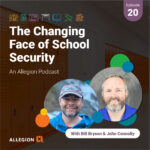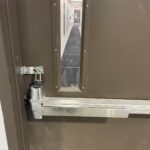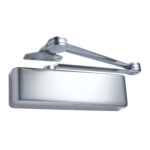This post was published in Doors & Hardware
One of the cardinal rules of doors in a means of egress is that the lock or latch must allow free egress without the use of any key, tool, special knowledge, or effort. The International Building Code (IBC) and NFPA 101 – The Life Safety Code, contain exceptions to this requirement for free egress, such as:
- The locking of detention / correctional occupancies,
- The use of a nightlatch or security device on a residential dwelling unit,
- Automatic flush bolts on a pair of doors when there is no doorknob or surface-mounted hardware on the inactive leaf, and
- Fire door hardware which is disabled after reaching the minimum elevated temperature defined by the fire test procedure (like the auxiliary pin on less-bottom-rod (LBR) fire exit hardware).
There is an additional exception in both of these codes for the use of a key-operated lock, which is typically a deadbolt with a key cylinder on both sides of the door. (Note: A section was added in the 2021 IBC which addresses egress doors serving exterior spaces.)
In the 2021 edition of the IBC, these exceptions are covered in section 1010.2.4 – Locks and Latches. Several criteria must be met in order to allow the use of a key-operated lock on the egress side of the door:
- The use group must be one of the following:
- Assembly occupancy with an occupant load of 300 people or less,
- Business, factory, mercantile, or storage occupancy, or
- A place of religious worship.
- Key-operated locks are limited to the main door or doors in these occupancy types (previous editions of the IBC specified that key-operated locks could only be used on the main EXTERIOR door or doors). Because only the main door is allowed to have a key-operated lock, employees who are in the building when it is locked are expected to have access to other exits that do not require the use of a key.
- The locking device must be readily distinguishable as locked – typically the lock will have an indicator which reads “open” or “locked.”
- Signage on the egress side of the door or adjacent to the door must state THIS DOOR TO REMAIN UNLOCKED WHEN THIS SPACE IS OCCUPIED. The letters on the sign must be at least 1 inch high on a contrasting background. This signage serves as a reminder to employees, but also advises the public that the door must be unlocked when they are present.
- A building official may revoke the use of a key-operated lock for due cause.
The 2021 edition of NFPA 101 addresses key-operated locks in section 7.2.1.5.6. This section is slightly different from the IBC requirements; for jurisdictions where both codes are used, a blend of the most stringent requirements may be necessary:
- Key-operated locks on the egress side of a door are limited to exterior door assemblies and interior door assemblies to an individual tenant space or to a single tenant space, where allowed by the occupancy chapters (consult the applicable occupancy chapter to see whether a key-operated lock is acceptable).
- When a key-operated lock is installed, a readily visible, durable sign must be located on or adjacent to the door, reading: THIS DOOR TO REMAIN UNLOCKED WHEN THE BUILDING IS OCCUPIED or THIS DOOR TO REMAIN UNLOCKED WHEN THE SPACE IS OCCUPIED. The letters on the sign must be at least 1 inch high on a contrasting background.
- The lock must be readily distinguishable as locked – typically with an indicator that reads “open” or “locked.”
- A key must be readily available to all occupants inside the building when it is locked.
- An Authority Having Jurisdiction (AHJ) may revoke these provisions for cause.
- As stated in Annex A, if the entrance consists of a vestibule, the key-operated lock may be installed on either the exterior or interior door of the vestibule.
According to NFPA 101, a building is “occupied” when one of the following is true:
- It is open for general occupancy,
- It is open to the public, or
- It is occupied by more than 10 persons.
A building that is not open for general occupancy or open to the public, that is occupied by 10 people or less, would be considered “unoccupied.” The Code recognizes that there may be custodians or security personnel inside the building when it is locked. These occupants are generally familiar with the facility, and they must have access to keys as required by the code. It is not the intent of the code to allow people to be locked inside of a building without a means of egress, even if the number of occupants is 10 or less.
One question that often arises is whether another type of deadbolt would be acceptable – either a deadbolt with a key on the exterior and a thumbturn on the interior, or a classroom function deadbolt (the thumbturn can retract the bolt to unlock the door, but cannot project it to lock the door). The biggest factor in that determination is whether the deadbolt is being used as an alternative to panic hardware. Panic hardware is typically required for assembly and educational occupancies*, with an occupant load of 50 or more (2006 IBC or later) or 100 or more (NFPA 101).
If panic hardware is required, the codes allow the use of key-operated locks as an alternative for some assembly occupancies – depending on the occupant load. For these occupancies, the code is specific – either panic hardware is required or a key-operated lock may be used if all of the criteria are met. In this situation, the code does not allow any other type of lock.
For doors that do not require panic hardware, the code does not restrict the use of a deadbolt with a thumbturn, as long as the hardware meets the requirements for operable hardware:
- If the door is on an accessible route, the hardware shall not require tight grasping, tight pinching, or twisting of the wrist to operate. The code is not prescriptive with regard to the size/shape of thumbturns, but many code officials use the side of their palm or the tip of a pencil to determine whether a thumbturn requires tight grasping, tight pinching, or twisting of the wrist to operate. Many manufacturers offer thumbturns that meet these requirements.
- Operating hardware must be installed a minimum of 34 inches and a maximum of 48 inches above the finished floor. The IBC allows locks used only for security purposes and not for normal operation to be mounted at any height. NFPA 101 allows existing security devices to be mounted up to 60 inches above the floor. Consult codes for exceptions related to swimming pool doors and gates.
- The unlatching of any door leaf must not require more than one operation. Consult codes for exceptions related to manual and automatic flush bolts, residential dwelling units, and detention facilities.
If a deadbolt is of a design that meets all of these criteria, and the door is not a fire door which requires an active latchbolt for positive-latching, then the code would not prohibit the use of these deadbolts as long as the occupancy type/load does not mandate panic hardware.
As always, local code requirements may vary from the national codes referenced here, and the Authority Having Jurisdiction has the final say. This article is based on my research and interpretation of the codes, and may differ from the interpretations of others.
* There are additional requirements for panic hardware on High Hazard occupancies in both codes, and NFPA 101 also requires panic hardware on Day Care occupancies.
You need to login or register to bookmark/favorite this content.






I’m a day late and a dollar short in responding to this, but here goes. “For Assembly occupancies (12/13.2.2.2.4), key-operated locks are limited to a single door or a single pair of doors which serve as the main exit, and the occupant load may not be more than 500 for new facilities, and 600 for existing.” This is rather shocking to me, that they would allow the possibility of the “main exit” door to accidentally be locked with that big of an assembly. Am I missing something? Also, we do a lot of residential deadbolt installations and we have been telling customers they can’t be double cylinder. Are we correct?
You’re not late at all – the conversation is ongoing! The intent behind this exception is that theoretically the building can’t function / be open with this particular door (the main entrance) locked. And it can’t be accidentally locked if it’s key-operated (vs. a thumbturn). We do not see this exception used a lot in New England, but there are some old churches that don’t have panic hardware on the main entrance and this covers them. I’ve also seen it on Mercantile occupancies.
The residential requirements vary depending on which code is in use in the jurisdiction, but this is the section from the 2009 International Residential Code:
R311.2 Egress door. At least one egress door shall be provided for each dwelling unit. The egress door shall be side-hinged, and shall provide a minimum clear width of 32 inches (813 mm) when measured between the face of the door and the stop, with the door open 90 degrees (1.57 rad). The minimum clear height of the door opening shall not be less than 78 inches (1981 mm) in height measured from the top of the threshold to the bottom of the stop. Other doors shall not be required to comply with these minimum dimensions. Egress doors shall be readily openable from inside the dwelling without the use of a key or special knowledge or effort.
Lori,
You wrote that “the code does not restrict the use of a deadbolt with a thumbturn, as long as the hardware meets the requirements for operating hardware” but by definition, wouldn’t a deadbolt with a thumbturn violate the third bullet point since it requires more than one operation: one to release the deadbolt and a second to operate the lever? I frequently see business occupancies with a simple thumbturn deadbolt on the front door with no locked/unlocked indicator and no special text nearby either. This appears to violate IBC 1008.1.9.3 prohibiting locks, 1008.1.9.4 prohibiting manual flush/surface bolts (even though it’s not exactly the same thing), and 1008.1.9.5 prohibiting more than one operation. What am I missing here? Can you please elaborate on this portion of the topic? Thank you!
Hi Josh –
The criteria that followed my statement about deadbolts were (I’m paraphrasing):
No tight grasping, tight pinching, or twisting of the wrist to operate.
Mounted between 34 inches and 48 inches above the finished floor.
One operation to unlatch (with exceptions).
Not a fire door which would require positive latching.
Not required to have panic hardware.
If the door had a deadbolt and a lever as you described, it would not meet the third criteria of one operation and would not be acceptable. If the door had just a deadbolt, was not a fire door, was not a door that required panic hardware, and the deadbolt was mounted between 34″ and 48″ AFF and the thumbturn could be turned without tight grasping, tight pinching, or twisting of the wrist, then it would be acceptable.
– Lori
Is a double keyed deadbolt allowed with push/pull hardware for use on an unoccupied bathroom, except the person cleaning it, and the lock is only used for maintenance reasons?
Hi Scott –
Technically, no – double-cylinder locks are limited to the main entrance door(s). I would use either a classroom deadbolt or the new function that I wrote about a while back: http://idighardware.com/2014/07/wwyd-school-multi-stall-bathrooms/.
– Lori
Hi Lori-
Thanks for this article, I refer to it almost every time I’m working on hardware.
I have a question that follows up on your answer 1a above regarding the intent of allowing an exception for panic hardware on the main doors of an assembly space is because the building theoretically wouldn’t be open if these doors were still locked.
I have a client who would like to omit the panic hardware on the main entry doors (Assembly >50, <300), so we will require a keyed cylinder and sign on the interior, but they don't want a cylinder on the exterior because they will enter from a side door to open the building, and unlock the entry doors as required when they open. So the doors will be unlocked when open for business, as required, but not because that's how they entered (if that matters).
Is there a requirement for a keyed cylinder on the exterior of the front doors (double keyed cylinder) or can it be un-enterable when locked from inside?
Thanks!
Hi Brett –
I have not seen a requirement for an outside cylinder, but I did see a recent request from a fire marshal to add a cylinder for fire department access. I think to avoid this problem it would be best to include an outside cylinder unless there is a good reason not to have one.
– Lori